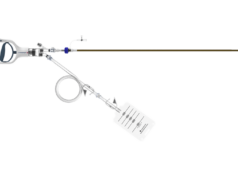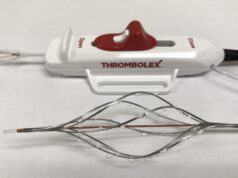
It has been found by the EXTRACT-PE trial, a multicentre investigation conducted under an investigational device exemption (IDE) from the US Food and Drug Administration (FDA), that aspiration thrombectomy for acute pulmonary embolism (PE) with the Indigo Aspiration System meets primary efficacy and safety endpoints. The study showed a reduction in the right-to-left ventricle diameter (RV/LV) ratio, as well as a low major adverse event rate.
Akhilesh Sista (NYU Langone Health, New York, USA), national principal investigator of the EXTRACT-PE study, presented the results at 2019 Vascular Interventional Advances conference (VIVA; 4–7 November, Las Vegas, USA). Describing the study rationale, he said: “Systemic thrombolysis is associated with lower mortality and clinical deterioration, but higher major bleeding than anticoagulation alone in submassive or intermediate-risk PE.”
“Catheter-directed thrombolysis has been used as an alternative to systemic thrombolysis and has been shown to relieve right-ventricle (RV) strain,” added Sista, “but it also carries a bleeding risk because it uses a thrombolytic drug”. As a result, catheter-based aspiration thrombectomy, without thrombolytic drug administration, is considered to be a promising solution. However, the speaker emphasised that it had not been prospectively studied, prompting this investigation.
The objective of EXTRACT-PE, a prospective, single-arm trial, was to evaluate both the safety and efficacy of aspiration thrombectomy with the Indigo Aspiration System, in patients with acute PE, and without the use of thrombolytic drugs. In terms of efficacy, the primary endpoint was a reduction in RV/LV ratio from baseline to 48 hours, which would be met if the lower bound of the confidence interval (CI) was less than 0.2. The primary safety endpoint was the rate of major adverse events within 48 hours, including device related death, major bleeding, or a composite of clinical deterioration, pulmonary vascular injury, or cardiac injury.
Outlining the eligibility criteria for the study, Sista said: “The inclusion criteria included patients with symptomatic acute PE of 14 days or less in duration, as diagnosed by computed tomography angiography (CTA), and systolic blood pressure of more than 90mmHg with evidence of an RV/LV ratio of less than 0.9. The patient also needed to be 18 years or older.” Alternatively, key exclusion criteria included tPA administration within 14 days of the CTA, pulmonary hypertension with a peak pulmonary artery(PA) pressure of greater than 70mmHg, a high FiO2 requirement, or cardiopulmonary surgery within the last seven days.
Ultimately, 119 patients were enrolled in the study, with two populations analysed as part of the investigation. In the intention-to-treat population of all 119 patients, a primary endpoint was available in 113, as six did not have an RV/LV ratio available at 48 hours. Moreover, there was a modified intention-to-treat population which excluded patients who were treated with thrombolytic drugs during the peri-procedural period or an adjunctive device within 48 hours. This population, which also excluded four patients who did not have an LV/RV ratio at 48 hours, included 106 persons for whom a primary endpoint was available.
In addition to a statistically significant reduction in on table PA pressure, which went from 49mmHg pre-procedure to 44.5mmHg post-procedure (95% CI 3.0–6.4 [p<0.0001]), the primary efficacy endpoint was met, with the procedure achieving a 0.43 reduction (27.3%) in the RV/LV ratio on average (95% CI 0.38–0.47 [p<0.0001]) after 48 hours. Across both of the patient populations analysed, this same result was found.
Turning his attention to the primary safety endpoint, Sista revealed that two patients experienced a total of 3 major adverse events within 48 hours (a rate of 1.7%); “the first patient had a groin access site bleed,” the presenter explained, “while the second patient had haemoptysis, which was stabilised in the suite”. However, as Sista went on to reveal, “the patient died 11 hours post-procedure due to a sustained ventricular tachycardia”.
Compared to other trials which have tested for similar efficacy and safety endpoints, the results of EXTRACT-PE correlate with SEATTLE II and FLARE in terms of the change in RV/LV ratio, though the percentage of major adverse events within 48 hours compares favourably. In summary, Sista also pointed to some additional features of interest, stating: “There was a 37-minute Indigo procedure time and, of note, intraprocedural thrombolytic drugs were not used in over 98% of the patients enrolled in this trial.”
In a press release, Sista commented further: “The positive results of the EXTRACT-PE trial, the first prospective safety and efficacy study of the Indigo Aspiration System, are a step forward in building needed clinical evidence around catheter-based embolectomy in patients with acute pulmonary embolism.”












